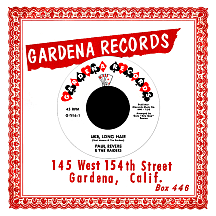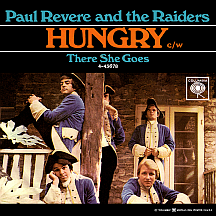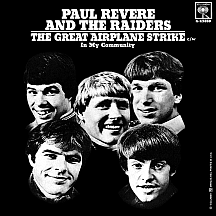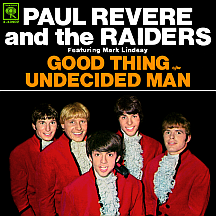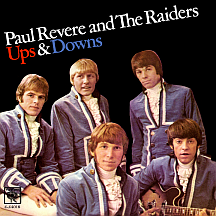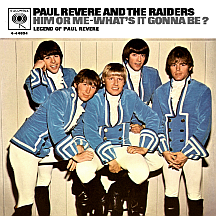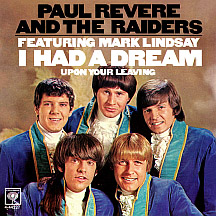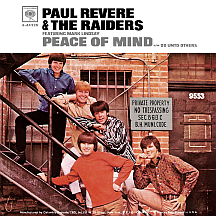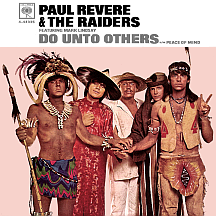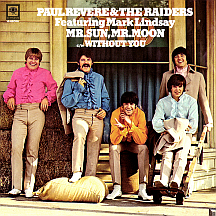PAUL REVERE
AND THE RAIDERS
Of all the acts that sprang up out of the Pacific Northwest during rock and roll's early years, Paul Revere and the Raiders were the most fun-loving of the bunch, possessing the ability to excite an audience and make them cry out for more. A number of "lucky breaks," as Revere called them, led to more than a decade of strong record sales, big radio hits, persistent touring and the most prominent television presence of just about any music act of the 1960s. This success hinged on two distinct personalities: Harvard, Nebraska-born Paul Revere Dick spent most of his early life in Caldwell, Idaho, about 30 miles east of Boise, while the four-years-younger Mark Lindsay, born in Eugene, Oregon in 1942, moved to the same area and began singing at age 15 with a local band, Freddy Chapman and the Idaho Playboys. A chance meeting yielded many years of rollicking good times.
Revere had worked as a barber at age 18 and by 1958 he owned a small walk-up/drive-thru burger restaurant in Caldwell called Reed & Bell Root Beer, which he kept running even after his music career had kicked in. Lindsay had a job as a baker but walked out after meeting and singing for Paul one night at the Elks Lodge in Caldwell. Both were fans of Jerry Lee Lewis, the pumpin' piano man doing "Whole Lotta Shakin'" and "Great Balls" business on the charts at the time. Paul and Mark joined foces in a band called The Downbeats, performing mostly instrumentals and gaining a word-of-mouth reputation in Southern Idaho and parts of Washington and Oregon. In 1960, after recording some songs in a local studio and shopping the tapes around, they got a bite from John Guss, the owner of a small L.A.-based label, Gardena Records, who suggested taking advantage of Revere's given name, which the two had previously considered. They thought Night Riders sounded good but settled on the Raiders (same as Tommy Sands' recently-defunct backing band) and promoted themselves as "the wildest sound for miles around."
"Beatnick Sticks" (a variation on the 1877 standard "Chopsticks" by composer Arthur De Lulli) was the first Paul Revere and the Raiders single on Gardena. Organist Revere led the band and saxophonist Lindsay sang on songs like "Paul Revere's Ride." Robert "Moonie" White (co-owner of the drive-thru) played lead guitar while his brother, guitarist Dick White, and drummer Jerry Labrum, completed the quintet. They began working in Los Angeles with Gary Paxton (fresh off his "Alley-Oop" chart-topper); the idea of arranging classics as rock numbers was further explored with "Like, Long Hair," based on Sergei Rachmaninoff's 1892 "Prelude in C-Sharp Minor." This third single hit the national charts and entered the top 40 in April 1961.
Paul was drafted by the Army, leaving Mark and the band to go out on performance dates as Paul Revere's Raiders, though only for a short time as Paul was designated a conscientious objector. Paul and Mark cut their first album (Like, LONG Hair) with studio musicians, including some of the players involved in the creation of the similarly-conceived B. Bumble and the Stingers records. Portland, Oregon was the group's home base; Beaverton-born Michael "Smitty" Smith joined as their regular drummer in the summer of 1962.
Top 40 deejay Roger Hart of KISN, a Vancouver, Washington station that broadcast from downtown Portland and made "91-derful" the most popular spot on the radio dial, began promoting their local appearances on his show, which guaranteed packed houses. Roger became fast friends with all the Raiders and wound up as their full-time manager. The band's shows have since become the stuff of legends; the guys worked out choreographed steps that the crowd would mimic, Lindsay blew sax while hanging from the rafters if the building's interior design allowed for it, and Paul lit his piano on fire more than a few times. Musicianship was hot and tight and people rocked out at their shows. It was not unlike the kind of mania Jerry Lee had become famous for.
"Louie, Louie" by Richard Berry and the Pharaohs cast a long shadow in the years after the original 1957 recording, particularly in the Pacific Northwest, where Seattle's Rockin Robin Roberts (The Wailers' lead singer) had made it a regional favorite, a number one hit in April '61 on Seattle's top 40 station KJR. Raiders fans insisted they perform the song and it became a regular part of their repertoire. With Mark's boisterous vocals increasingly prominent as the instrumentals became less of a priority, they went into Northwest Recorders, a small studio in Portland, laid down the track and released it on Hart's label, Sande. Turns out Seattle rockers The Kingsmen recorded the song at the same place within days of Revere's version. Through Hart's connections, the Raiders signed with Columbia Records (despite the company's poor track record with rock and roll acts including Carl Perkins, Ronnie Self and The Collins Kids in the late '50s, though the recent signing of Dion was going quite well). But PR&R's "Louie, Louie" didn't get very far, crushed under the competition of the Kingsmen's allegedly "dirty" version on Wand Records, a number two Billboard and number one Cash Box smash late in the year.
There were Raiders roster shakeups in '63; Charlie Coe joined them briefly as guitarist, then Chicago native Drake Levin (nicknamed "The Kid") took his place while Mike "Doc" Holliday came on as bassist; the latter two had been in a band called The Surfers. "Louie - Go Home," unrelated to the previous single except by the name, was a solid jam...but it was going to take awhile for the band to break the barrier. About this time Paul and Mark spotted some Revolutionary War uniforms in a costume shop and, ever the pranksters, decided to wear them during their stage show. The gimmick went over so well they had suits with tricorn (triangular) hats custom-made and the look served as their trademark for several years. The next two singles were top-notch remakes of near-hits from '60 and '61, Aaron Neville's "Over You" and "Sometimes," a west coast smash for Gene Thomas (as "Sometime"). Another ex-member of the Surfers, Burbank-born Phil Volk ("The Baby Raider"), joined as a bass replacement for Doc; his nickname, "Fang," would soon be quite recognizable.
Roger Hart pulled a few strings and was able to bring the group to the attention of Dick Clark, who hired them as regulars on his new weekday half-hour show for ABC-TV, Where the Action Is, a fondly-remembered series consisting of segments (essentially early black-and-white music videos) filmed all over the west coast and in many other parts of North America. The show premiered on June 28, 1965, a small-screen vehicle for regulars Linda Scott, Steve Alaimo and "Lies" guys The Knickerbockers, but it was Revere and his crew who benefited most. Terry Melcher (a key member of The Rip Chords) began producing the group's recordings, moving them away from their preferred R&B sound toward a more rocking approach typical of what U.S. bands were doing in a successful attempt at reclaiming the record sales and radio play that had been overtaken by British bands the previous year.
"Steppin' Out" marked a new phase for Revere's Raiders ('...don't lie to me!'); helped by some Action exposure, it climbed higher on the charts than any single since "Like, Long Hair." The next one was even bigger; a budding songwriter named Rick Day sent his song "Just Like Me" to Melcher, who wasted no time in getting a Raiders version on vinyl. The infectiously rocking track landed at number eleven in January 1966. While interviewing the group, Dick Clark mentioned a bet Mark had made that he would cut off his Continental soldier-era ponytail if the Raiders ever had a million-seller, pointing out that their first top ten, "Kicks," an anti-drug song penned by Barry Mann and Cynthia Weil, was getting close to the magic number. Eventually the ponytail disappeared. Another Mann-Weil tune, "Hungry" ('...I want the world now!'), likewise went top ten.
A side project by a mysterious group, The Unknowns, had some minor success in the fall of '66. Mark, Steve Alaimo and Action regular (and future Raider) Keith Allison made their own version of "Melody for an Unknown Girl," a ballad that had previously been recorded by Revere and the Raiders for the Midnight Ride LP. The single, on the Parrot label, spent a few weeks on the charts...and it got them in just a lil' bit of hot water with Columbia...but whatcha gonna do? "The Great Airplane Strike," a departure from any previous single (producer Melcher's ongoing goal), used studio musicians backing Mark's vocals and reached the top 20. Yet another roster change occurred when Drake Levin vacated and was replaced by Jim "Harpo" Valley; a former member of The Viceroys of Seattle and Don and the Goodtimes from Portland, he'd known Paul and the Raiders for several years. In November the band added a scripted-series TV credit to their fun-filled resumé when they appeared on ABC's blockbuster Batman series in the episode Hizzoner the Penguin.
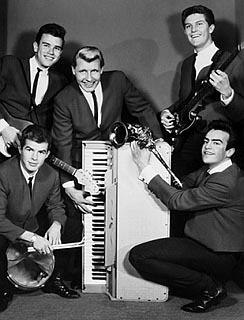
Mark and Terry began collaborating on most of the group's songs around this time. "Good Thing" featured some well-timed moans and groans from Mark and returned the act to the top ten in time for New Year's. A folky ballad by Levin (as dRAKE), "On the Road to Mexico," was produced by Steve Alaimo and appeared on the Parrot label. Jim Valley had already moved on by the time The Spirit of '67 hit stores near the end of '66, though he was on the cover and was profiled in the liner notes; he had solo singles released on Jerden and Dunhill over a period of several months in 1967. Meanwhile, Phil Volk (who'd frequently flipped his guitar over on TV to reveal the "Fang" nickname) married Tina Mason, a singer whose best moments were captured on every kid's daytime Action addiction. Then Phil left with Smitty and joined Drake in a new band, Brotherhood, materializing publicly the following year with an album on RCA.
Where the Action Is came to an end in March 1967 after more than 450 episodes, amounting to a treasure trove of footage from the recording acts of the early- to mid-'60s, particularly where PR&R are concerned. There were some great Melcher-helmed singles in 1967; "Ups and Downs" kicked off the year and the rapid-paced "Him or Me - What's it Gonna Be?" returned them to the top ten in May. Freddy Weller went through the Raiders' swinging door; he'd made a record as early as 1959 and had performed with many musicians during the '60s including Billy Joe Royal and Joe South. Drummer Joe Correro, Jr. came on board and guitarist Charlie Coe rejoined for a short stint. This and other incarnations of the band toured and made TV appearances while the recordings were almost entirely created by producer Melcher with studio musicians backing Lindsay (even Revere occasionally got involved with creating the music of the group that carried his name). It would be reasonably accurate to say that Paul and Mark were the band's only two permanent members.
Lindsay cowrote and supplied the lead vocal for Melcher's production of "I Had a Dream," a whimsical bit of semi-psychedelia that hit the top 20 in September '67. The band phased out the Revolutionary War outfits at about the same time other Columbia acts were going with a similar look: Gary Puckett and the Union Gap donned Union Army Civil War gear and The Buckinghams were suddenly shown wearing Confederate uniforms. Revere and the Raiders did some sessions with Chips Moman (the album Goin' to Memphis) and the result reflected the soulful atmosphere of Moman's American Recording Studio.
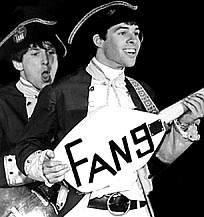
After "Peace of Mind," Melcher moved on, leaving Mark in a position to take over production. The '68 output consisted of solo Lindsay-penned hits: "Too Much Talk," "Don't Take it So Hard" and "Cinderella Sunshine." Paul, Mark and the latest Raiders hosted their own TV series, Happening '68 (later called It's Happening), for Dick Clark's production company; the show ran from January 1968 through the summer of '69. The hits kept coming: "Mr. Sun, Mr. Moon" and "Let Me" were written by Lindsay and each reached Billboard's top 20. Freddy Weller's side career started rolling; a cover of Joe South's "Games People Play" was a number two country hit in the spring of 1969, the first of more than 30 chart singles throughout the following decade. He remained with Paul Revere and the Raiders through 1971.
Mark Lindsay worked out a deal with Columbia to make solo recordings while continuing as the lead singer of the band. "First Hymn from Grand Terrace," a Jimmy Webb composition, was his solo debut. New Yorker Kenny Young, a songwriter who'd been active for several years, had penned hits by The Drifters ("Under the Boardwalk"), Herman's Hermits ("Just a Little Bit Better"), Ronnie Dove and others. He and producer Jerry Fuller (who'd been affiliated with Rick Nelson and Puckett's Union Gap) supplied Mark with his two biggest hits: "Arizona" made the top ten in February 1970 and "Silver Bird" had a nice top 40 run during the summer.
Mark convinced Paul to abbreviate the band's name; Paul went with the flow and they became, simply, The Raiders. After a couple of weak-performing 1970 singles, Mark came across an older song, "Indian Reservation (The Lament of the Cherokee Reservation Indian)," which had been written by John D. Loudermilk in the '50s based on a story related to him by a Cherokee named Bloody Bear Tooth. Country singer Marvin Rainwater (who was part Cherokee himself) recorded the song in 1959 under the title "The Pale Faced Indian." In 1968, British singer Don Fardon (previously a member of "Take a Heart" band The Sorrows) had a top 20 U.S. hit with the song under its newer title, then it made the U.K. top ten when re-released in the fall of 1970. Mark (who also had Cherokee ancestry) liked the song and considered it for a solo single. It ended up being a Raiders song, the group's biggest ever, number one in July 1971 during a five-month chart run. Joe South's "Birds of a Feather" became their final top 40 hit in the fall.
Both group and solo hits were harder to come by after this; Mark left the group in 1975 and the name reverted back to Paul Revere and the Raiders, as Paul focused more on crazy routines and a Spike Jones-inspired brand of humor in the presentation ("sophisticated corn," as Derek Taylor called it in the liner notes of the Spirt of '67 LP). Columbia canceled the group's contract at the ten year mark, in 1973. A couple of later singles included 1975's "The British Are Coming" on 20th Century Records with lead singer Omar Martinez.
Mark Lindsay has tirelessly continued to perform and make records. Phil Volk put together a live show with his wife Tina Mason, their daughters Kelly and Jessica and other family members. Paul Revere fronted the Raiders (playing a tricked-out organ made with the front end of a vintage Ford Mustang) until his death in 2014. A version of the group still tours as Paul Revere's Raiders, but there are no longer any members from their 1960s heydey. Think of them as a very good tribute band offering fans a reasonable facsimile of the experience of seeing one of the best rock and roll shows of the '60s and '70s.
NOTABLE SINGLES:
- Beatnick Sticks - 1960
- Paul Revere's Ride - 1960
- Like, Long Hair - 1961
- Louie, Louie /
Night Train - 1963 - Louie - Go Home - 1964
- Over You - 1964
- SS 396 - 1965
- Sometimes - 1965
- Steppin' Out - 1965
- Just Like Me - 1966
- Kicks - 1966
- Hungry - 1966
- Melody for an Unknown Girl - 1966
by the Unknowns - The Great Airplane Strike - 1966
- Good Thing - 1967
- On the Road to Mexico - 1967
by dRAKE - Ups and Downs - 1967
- Him or Me - What's it Gonna Be? - 1967
- There is Love - 1967
by Jim Valley - I Had a Dream - 1967
- Try, Try, Try - 1967
by Jim Valley - Go-Go Round - 1967
by Jim Valley - Peace of Mind /
Do Unto Others - 1967 - Too Much Talk /
Happening '68 - 1968 - Don't Take it So Hard - 1968
- Cinderella Sunshine - 1968
- Jump Out the Window - 1968
by Brotherhood - Mr. Sun, Mr. Moon - 1969
- Let Me - 1969
- Don't Let Go - 1969
by Brotherhood - First Hymn from Grand Terrace - 1969
by Mark Lindsay - We Gotta All Get Together - 1969
- Arizona - 1970
by Mark Lindsay - Just Seventeen - 1970
as the Raiders - Miss America - 1970
by Mark Lindsay - Silver Bird - 1970
by Mark Lindsay - And the Grass Won't Pay No Mind - 1970
by Mark Lindsay - Indian Reservation (The Lament of the Cherokee Reservation Indian) - 1971
as the Raiders - Birds of a Feather - 1971
as the Raiders - The British Are Coming - 1976


